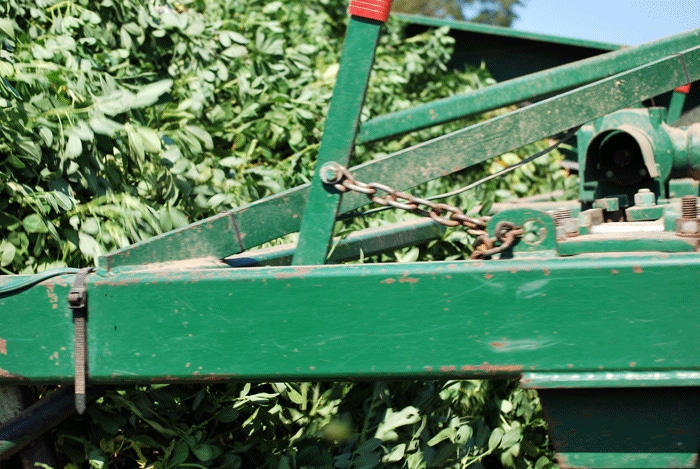September 18, 2014

“A tale of two halves.” It’s a phrase often used by sports commentators to describe changing momentum in a football game, but it’s also is an apt summary of Georgia’s 2014 peanut production season.
“As wet as we were early in the season, things have completely reversed and gone in the opposite direction,” said Scott Tubbs, University of Georgia Extension cropping systems agronomist, during the kick-off of this year’s Georgia Peanut Tour. The tour began just outside Savannah, Ga., and toured fields and shelling and handling facilities throughout the southeastern region of the state.
Georgia peanut producers have faced a number of challenges in 2014, including delayed planting due to wet fields and cool soil temperatures and extremely dry conditions during the peanut plant’s most critical time for water use, said Tubbs.
As the planting season began, large amounts of rain kept farmers out of the fields at a time when they normally would have been preparing their land, he said. Despite this, planting ran slightly ahead of average since some areas that received early rains in April did not receive as much in mid-May, while other areas that received large amounts of rain in mid- May did not see as much in late April.
“We saw an odd planting season, and the crop that’s out there now really varies by area and even varies by the farmer in some cases,” said Tubbs.
Cool soil temperature was another issue faced by growers this year. UGA recommendations call for planting peanuts after soil temperatures reach at least 68 degrees F. at 4 inches deep for three consecutive days.
Initially, soil temperatures reached the recommended target, but then near the end of April, rainfall caused them to drop below 60 degrees F. “That’ll shock the seed and a lot of it won’t come up and create the plant stand you’re looking for. On average, in 2014, we stayed ahead of the five-year average and ahead of 2013 in terms of total plantings.
“Some farmers started planting at the end of April, but then another dip in temperature in May delayed planting. Farmers watching the weather forecast likely did not plant, and some of those that did plant had poor emergence and plant stand issues,” he said.
The months of April and May in southwest Georgia marked only the fourth time on record since 1895 that the area received more than 14 inches of rainfall. South-central Georgia, meanwhile, received its highest average rainfall on record during April and May. However, the tables turned in July and August, when the same area received its second-lowest amount of rainfall since 1895 – a mere 6 inches. Other areas saw 2 inches or less for the same two-month timeframe.
“If you’re irrigated, you can water as needed and meet these water needs. But if you don’t have irrigation, which would include about 50 percent of our peanut acres, you’re in a time frame where your peanuts require 1 ½ to 2 inches of rain per week to meet the needs of the crop," he said.
Georgia producers saw a record-high peanut yield in 2012, when they received 13.6 inches during that five-week critical-use timeframe, said Tubbs. “And this past year was trending much closer to that water-use curve than this year. Our total yield this year will be much lower than what we were expecting.”
Many farmers received rainfall in September, but it may to too late to do them any good. “Any flowering or pegging peanuts at this time do not have enough time to mature, so recent rains may help finish off the set crop and advance grade, but it will not help yield much except in very late planted peanuts or plants that have a lot of small swelling pods. So, the bottom line is a mixed crop outlook throughout Georgia for peanuts," he said.
Declining yields might firm up prices
If there’s a bright side to lower peanut yields this year, it might be the effect it’ll have on the U.S. market, said Nathan Smith, UGA Extension economist.
“We’re looking at declining conditions and declining yield predictions in Georgia,” said Smith, during the first day of the state’s annual peanut tour.
While NAAS has the statewide average yield pegged at 4,000 pounds per acre, other models are below that number, ranging from 3,500 to 3,900 pounds per acre, said Smith.
“USDA has updated our supply and demand, and they have us at 926,000 tons of carry-over. If we’re at about 3,700 pounds per acre for the U.S. average, on 1.3 million acres, it would leave about 850,000 tons of carry-over. If the average yield drops to 3,600 pounds per acre, we drop to below 800,000 tons on carry-out.
“If we abandon 5 percent of the acreage, add more crush and residual due to quality problems, and still had 3,800-pound yields, it would drop us down to about 800,000 tons. It’s looking more and more like we might be able to work down some of these ending stocks just from the production side. That hopefully will firm up prices,” said Smith.
FSA’s latest peanut crop estimate has Georgia at 589,370 acres and a U.S. crop of 1.328 million acres.
About the Author(s)
You May Also Like




